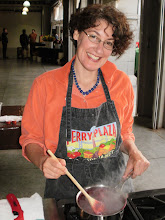So, vast amounts of virtual ink have been spilled regarding Mark Bittman and Jim Lahey's 'no-knead' bread recipe. Being a sucker for fabulous bread, especially if it comes out of my own kitchen, I had to try it, and now, by loaf #3, I think I'm getting the hang of it.
In case you've been following other news (Iraq, the TomKat wedding, where to get lard for your Thanksgiving pie crusts*) the deal is very simple: a really wet dough made from 3 cups (15 oz) of flour, salt, yeast, and water, stirred up and left to rise without kneading for 12-18 hours. The dough is shaped on a floured towel, left to rise for another 2 hours. Meanwhile, a heavy pot with a lid (like cast iron or enameled cast iron) is heated up in a 450 F oven for at least 30 minutes. The dough is flung into the hot pot, the lid clapped on, and the bread baked for 30 minutes lid on, and another 15 minutes lid off. The combo of wet (or slack) dough, a very long, slow rise, and a very hot, enclosed baking environment results in a bread that's very close to a typical "artisanal" loaf, with a moist, open, holey crumb and a thin, crackly crust.
I still haven't tried making it with all white flour, since I prefer whole grains, but here's what I've learned:
More salt. The original recipe calls for 1 1/4 tsp, but that's not enough, and the bread tasted flat. I've gone up to a scant 2 tsps of fine-grain sea salt, which seems to be perfect.
A little less water. 1 1/2 cups is great, and makes a dough that's slack but can still be handled without tons of excess flour.
Active dry yeast, rather than instant yeast, is fine. I dissolve mine in the water and let it sit for a few minutes to wake up. After reading that instant yeast was more potent, I increased my yeast to 1/2 tsp; however, this made a dough that was so lively (relatively speaking) that I had to stir it down after about 9 hours, and let it rise again for the second 6 to 8 hour stretch. I did another loaf with 1/4 tsp, and it still rose very well.
Rubbing the rising towel with rice flour works very well, as the dough doesn't stick like it would to regular flour. If I had a peel, though, I'd let it rise on the peel, as getting the dough from the heavily floured towel onto the baking stone or pot meant flinging flour everywhere, and deflating the risen dough somewhat.
Baking: I had very good results dropping the dough into my bitsy (2 qt) Le Creuset pot (except that, at 500F, the bottom crust burned) and even better results by using my baking stone and an inverted cast-iron dutch oven at 450 F. I also slashed the crust with a razor blade before baking, which seemed to help with oven spring. Plus, slashing the cross gave it a nice professional look that made up for the somewhat irregular shape caused by my peel-less attempt to scoop the risen dough off the towel by hand.
So far, I've used a 2:1 mix of whole wheat and rye, which made a rather flat loaf; 2:1 white and whole wheat, which rose well and had a great holey open-crumb structure; and 2:1 whole wheat and white, which rose well but produced a slightly denser interior with fewer holes. All of these had a fairly thin crust that was more chewy than crackly; I'm still pondering how to get that true crackly crust.
*Why am I such a sucker for things journalists say? But pie queen as I am, I've always hankered to try making a lard crust, and the Times' recent paen to Flying Pigs Farm's fabulous rendered leaf lard (the best kind, taken from around the kidneys) got me longing for the stuff. And then, after yesterday's trip to the Botanic Garden, I found myself browsing through the Grand Army Plaza farmer's market...and there was the Flying Pigs stand, with lotsa lard on offer. Having just come from a conference on Food, Ethics and the Environment down at Princeton (more on that to come), I was a particularly soft touch for any products coming from a small family-owned farm where the pigs get to run around and act like pigs like to act. So now I've got a tub o' lard in my fridge, waiting to be turned into pies for Jane's day-after-thanksgiving. Reports to follow...
Subscribe to:
Post Comments (Atom)

1 comment:
OK, hold on a sec... do you recommend this as "the best" or at least a "very good" way to get a nice bread loaf? Pardon my ignorance, but I'm a newbie baker (am more concerned with cooking, and tasting along the way!) so am wondering if this would be your recommended recipe for an everyday loaf? Or should I stick with the regular loaf-pan technique?
Post a Comment